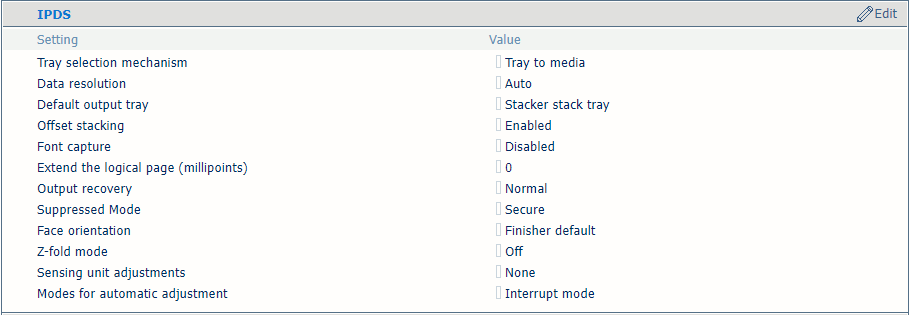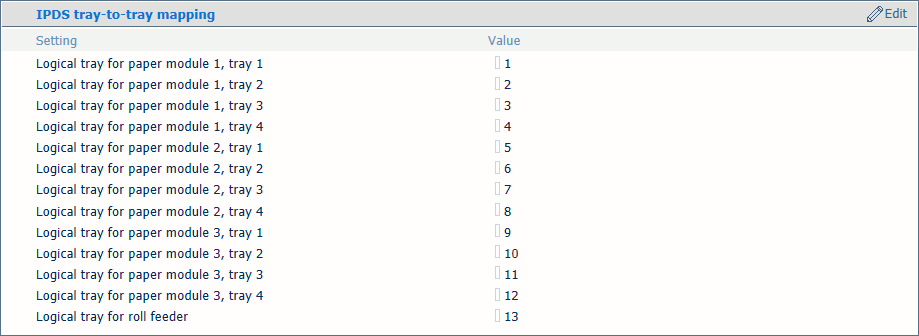

A transaction setup with the status [Opened] can be adjusted.
Open the Settings Editor and go to: .
 [Transaction setups] tab
[Transaction setups] tabCheck that the transaction setup you want to change has the status: [Opened].
 [Transaction setups]
[Transaction setups] Click the [IPDS transaction setup] tab.
 [IPDS transaction setup] tab
[IPDS transaction setup] tabChange the settings one by one or click [Edit] in the title bar to adjust the settings of a group in one dialog box.
Validate the transaction setup.
Make sure that you reload a transaction setup that is active when you make the changes.
 IPDS transaction setup settings
IPDS transaction setup settings|
[IPDS] settings |
Description |
|---|---|
|
[Tray selection mechanism] |
A transaction printing job always uses the media definitions as specified in Settings Editor. Select [Tray to tray] or [Tray to media]. The IPDS data stream contains a reference to a logical tray. There are 36 logical trays that can be assigned to a physical paper tray ([Tray to tray] ) or to media of the media catalog ([Tray to media] ). |
|
[Data resolution] |
Select the resolution of the bitmaps the printer accepts. |
|
[Default output tray] |
Select the default output tray. |
|
[Offset stacking] |
Select if stacking occurs with or without an offset. |
|
[Font capture] |
Indicate if fonts and other resources can be captured to the printer disk. |
|
[Extend the logical page (millipoints)] |
When you want to print with a slightly larger page size, you can increase the logical page size with the entered number of millipoints (unit of angle measurement). |
|
[Output recovery] [Suppressed Mode] |
Adjust the error recovery method to keep the printed output according to the original source. First select [Suppressed], and then use the [Suppressed Mode] mode to select [Secure].
|
|
[Face orientation] |
Select the delivery orientation in the output tray: [Face up] or [Face down]. |
|
[Z-fold mode] |
When a mixed-size set must both be Z-folded and stapled. |
|
[Sensing unit adjustments] [Modes for automatic adjustment] |
The sensing unit can automatically perform media registration and density adjustment via three ways. Use this setting to select the media registration, density or both for automatic adjustment in the sensing unit. The sensing unit can automatically perform media registration and density adjustment via two modes during printing. Use this setting to select one of the two modes. In continuous mode, every sheet in the print job is used for the media registration and density adjustment. In interrupt mode, a print job is interrupted to print a chart which is used for the media registration and density adjustment. |
 [IPDS image shift] settings
[IPDS image shift] settings|
Image shift settings |
Description |
|---|---|
|
[Image shift in feed direction of side 1] [Image shift in cross-feed direction of side 1] |
Use these settings to define the image shift. When you use pre-printed media with marked areas for specific text, misalignments can occur. Also use this setting to better align variable data on pages, such as names or addresses. There are settings for the feed direction and the cross-feed direction in combination with the sheet side. You can also adjust the image shift on the control panel. |
 [Color management] settings
[Color management] settings|
Color management settings |
Description |
|---|---|
|
[Default CMYK input profile], [Default monochrome CMYK input profile], [Default RGB input profile], [Default monochrome RGB input profile] |
Select a default input profile for the four types of input profiles. |
|
[Rendering intent] |
Select the rendering intent. |
|
[Print full color or black & white] |
Use this setting to define how jobs are printed: in black & white or in color. |
|
[Ignore toner transfer curve from data stream] |
The printer can use or ignore toner transfer curves that are in the data stream. |
|
[Ignore embedded output profile] |
Use this setting to ignore the RGB or CMYK embedded output profiles. |
|
[Black preservation] |
Use the setting to apply pure black preservation when possible. Pure black preservation means that the color black is composed of 100% K ink. When pure black preservation is not possible or disabled, the color black is composed of a mixture of two or more C, M, Y, and K inks. |
|
[Halftone] |
Indicate the halftone. |
 PDF settings
PDF settings|
PDF attributes |
Description |
|---|---|
|
[PDF spot color 'All'] |
PDF data have a number of pre-defined spot color names. The color name 'All' means that the RIP uses a 100% coverage of all the available colors. The color 'All' is intended for alignment marks. You can force the RIP to only use 100% black. Note that if the printer supports a separate MICR station, the color name 'All' implies that MICR pixels are used as well. |
|
[PDF enable cache] |
Indicate if you want to use the PDF cache to automatically identify and store objects that are used more than once in the job. |
|
[PDF overprint simulation] |
Indicate if simulation of overprinting of all colors must be applied. If this setting is disabled, the colors on top will knock out all underlying colors. |
You link logical trays (indicated by a number from 1 to 15) to physical paper trays. The printer uses media that are assigned to these physical paper trays. The schedule shows the media the job uses.
 [IPDS tray-to-tray mapping] settings
[IPDS tray-to-tray mapping] settingsDefine the logical tray values for all physical paper trays the jobs use.
You link logical trays (indicated by a number from 1 to 36) to media of the media catalog. The printer maps the logical tray to the physical paper trays that hold these media. The schedule shows the media the job uses.
 [IPDS tray to media for tray 2]
[IPDS tray to media for tray 2] Use the [Media catalog item] setting to select media from the media catalog.
Use the [Feed direction] setting to select the feed direction of the media.
Input trays that contain the same media as the tray defined for the job are automatically linked. This means that when one of the paper trays is empty, printing continues from another paper tray that holds the same media.
 [Color number and color names of cyan color station]
[Color number and color names of cyan color station] You can define custom names or numbers for the color stations.
|
Color station definition |
Description |
|---|---|
|
[Color number] |
When you want to select color stations by using a number, enter a unique value (1-254). The Black color station has the value of zero and you cannot change this number. The other default color numbers are:
|
|
[Color name 1] |
Names are encoded by UTF-16 Unicode. For every color station 6 names can be specified, to enable a color selection by a name. For the cyan, magenta, and yellow color stations, the default lists of color names are empty. The literally spelled names 'Gray', 'Cyan', 'Magenta ', 'Yellow ', 'Black ', 'All ', 'None' are reserved for PDF and cannot be used. |